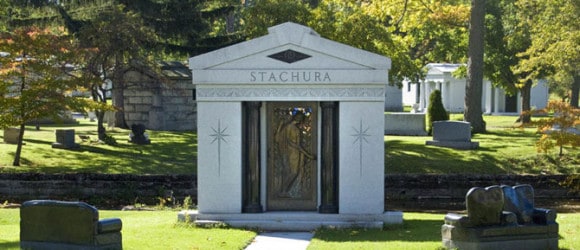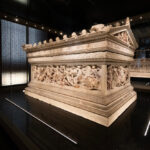Stachura Mausoleum: Last Impressions
- At March 29, 2013
- By Doug Keister
- In Doug Keister's Blog
0

We are all familiar with the saw, “you only have one chance to make a first impression.” Conversely, you only have one chance to make a last impression. A cemetery is, arguably, the best place to make that final statement.
Like many other cemetery explorers, I’m not particularly fond of cookie-cutter flat markers or overly simple plain-Jane tombstones. As a society we have pushed death and cemeteries away, thinking that somehow we’ll lead happier lives denying and defying death. But doing all we can to avoid death makes it harder to truly embrace life. I never feel so truly alive as I do in the midst of a cemetery.
One of my early cemetery excursions took me to a graveyard at the base of Stirling Castle in Scotland. The graveyard was peppered with 17th century tradesmen’s gravestones. These modest markers told me much more than many modern tombs. Carved into the stones were winged skulls telling me that the resident believed in the existence of a soul, (the rise of Scottish Presbyterianism heralded a more promising view of the afterlife) as well as other mortality symbols. More importantly, the stones were often embellished with the tools the person had used in their life. Here were masons and carpenters and weavers and sea captains with the tools of their trade. Those tools made it easier to picture that person even though they had died centuries ago.
After years of decline, the last couple decades has seen an increase in personalized funerary art in America. Thanks to improved laser cutting and other manufacturing techniques, modest markers, stately monuments, and grand mausoleums have once again become a canvas for personal statements. Tractors, race cars, family portraits, and pithy epitaphs are becoming more and more popular. These eternal statements certainly make it easier for the living to identify with the dead.
One of my favorite last impressions is the Stachura Mausoleum in Forest Lawn Cemetery in Buffalo New York. When Chester Stachura’s wife Gloria died, he had her interred in a Classical Revival mausoleum. To honor the couple’s marriage, Chester had two wedding rings with the couples’ wedding date carved into the pediment. But Chester didn’t stop there. After consulting with the cemetery, Chester ordered black granite reproductions of Chester and Gloria’s love seat and sofa so he could sit in front of the mausoleum and remember the times they had spent next to each other in their living room. Their signatures are carved into the love seat. Truly a personal statement. Perhaps British author George Eliot said it best: “Our dead are never dead to us, until we have forgotten them.” Chester didn’t want to forget Gloria. Their mausoleum guarantees that the passerby will remember them both.
[Douglas Keister Visit Doug’s Author Page] Google+
